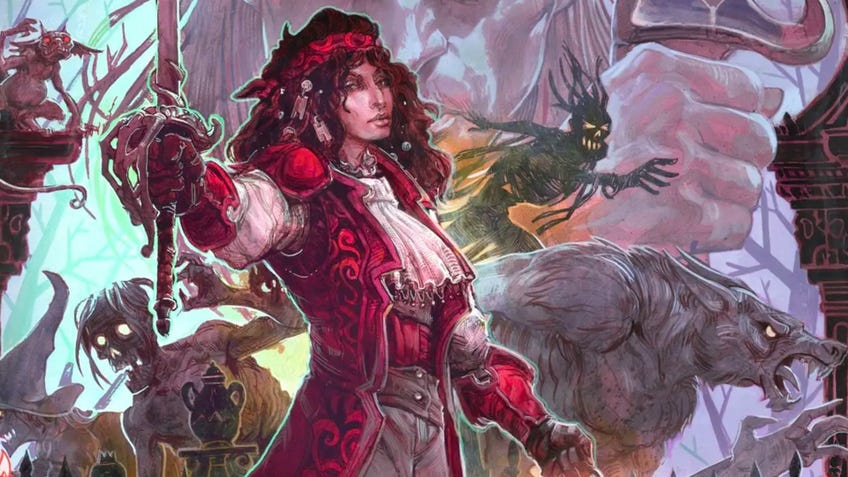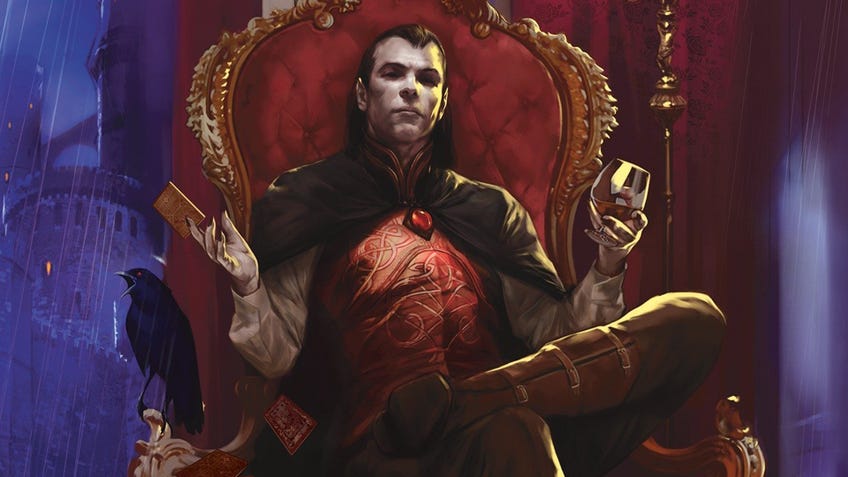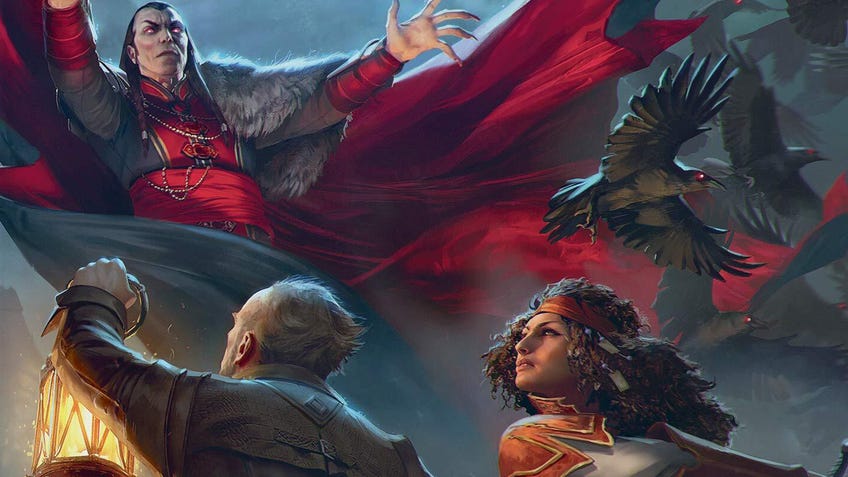How to run a Dungeons & Dragons 5E horror campaign for Halloween
From choosing a sourcebook to picking enemies.
Whilst there are plenty of explicitly horror-themed tabletop RPGs out there, there’s no denying the undying appeal of Dungeons & Dragons 5E. Principally known for being a fantasy RPG, D&D does have the potential to get spooky should the dungeon master and their players be willing to embrace the scarier side of its universe. From creepy locations to terrifying enemies, the world of D&D contains more than enough suitably scary things to make for a damned good horror campaign.
Though you might have played or even DM’d a game of Dungeons & Dragons 5E before, you might not know the first thing about injecting horror into the experience. Luckily for you, we’ve taken a look at the popular fantasy RPG and found several ways to make it a significantly spookier game. Selecting the right location for your adventure, the right storyline and enemies can transform your session into a frightfest. We even have some tips on how to create a horrifying atmosphere to really ramp up the scares.
Light some dinner candles, whack on the creepy soundtrack and get ready to frighten your players in our guide to how to run a horror themed Dungeons & Dragons 5E Halloween night.
Best horror campaigns for D&D 5E
Perhaps the easiest way to get started with a horror-themed night of Dungeons & Dragons is to pick a suitable campaign to run for your victims - I mean players. There are a number of excellent choices when it comes to scarier D&D 5E campaigns and your choice will entirely depend on the kind of spooky vibe you want to instill in your players.
For a gothic-style adventure, you can’t really go wrong with the Curse of Strahd campaign. First released as Ravenloft in 1983, the adventure is considered an absolute classic and has recently received an updated version with Curse of Strahd: Revamped. In the campaign, the players investigate the mysterious village of Barovia, which is home to Castle Ravenloft - your bog-standard creepy abode that most definitely has not got anything to do with vampires.
Alternatively, a more modern example of a great horror D&D adventure is Icewind Dale: Rime of the Frostmaiden. Released last year, Rime of the Frostmaiden is a wintery campaign that takes place in the far north in a region of the Forgotten Realms that’s best left… well, forgotten. Inspired by the likes of John Carpenter’s The Thing, Rime of the Frostmaiden is all about the terrors of isolation and feeling trapped in a dreadfully empty place - which is perfect for psychological horror.
Otherwise, there’s the Cthulhu-esque campaign of Ghosts of Saltmarsh - which has the party attempting to save a misbegotten coastal village from slimy underwater terrors - or the more demonically-charged Tales from the Yawning Portal, a book containing a collection of smaller adventures including the dreadful Tomb of Horrors and disturbing Dead in Thay. All in all, Dungeons & Dragons 5E is certainly not lacking in horrifying adventures to inflict on your players.
Best horror sourcebooks for D&D 5E
If you want to create and plan your very own horror-themed D&D 5E campaign, you can always look to the various Dungeons & Dragons 5E sourcebooks for inspiration. There are several very suitable options that you can use to make a spooky D&D game, despite the RPG being best known for fantasy.
The most obvious sourcebook to turn to - beyond the essential Player’s Handbook and Dungeon Master’s Guide - is Van Richter’s Guide to Ravenloft, a recently released tome that transports DMs and players to the gothic setting for the aforementioned Curse of Strahd campaign. Rather than having to follow a set storyline, Guide to Ravenloft enables the DM to create their own adventure using the locations, non-player characters, enemies and items found across the land of Barovia. Containing everything from horror-themed character backgrounds and subclasses to an overview of the devious Darklords that stalk the land, Van Richter’s Guide to Ravenloft is an ideal sourcebook for creating a horror-themed Dungeons & Dragons 5E Halloween night.

Alternatively, if you’re just hunting for horror-themed aspects to include in your D&D Halloween night, rather than a full-on setting, look no further than Mordenkainen’s Tome of Foes and Volo’s Guide to Monsters. Unlike Van Richten’s Guide to Ravenloft, these two D&D sourcebooks are not explicitly horror-themed. However, there’s plenty of scary stuff to be found within, whether it’s lore about the various planes and denizens of the Abyss or information about potential monstrous enemies to include in your campaign. Volo’s Guide to Monsters has a specific section on - you guessed it - various monstrous species, from absolute classics like Gnolls and Mind Flayers to lesser known species such as Hags.
Best horror monsters in D&D 5E
For some specific examples of horror-themed enemies to feature in your D&D 5E Halloween night - if you wanted to create more of a dungeon-crawler experience - we’ve collected a bestiary of spooky creatures to introduce to your players.
Within Mordenkainen’s Tome of Foes, there is a quintet of terrifying monsters called The Sorrowsworn: The Angry, The Hungry, The Lonely, The Lost and The Wretched. These monstrosities are literal emotions given physical form and mimic the darkest aspects of these feelings, whether that’s aggression or misery. Besides their disturbing appearance, these creatures are especially unpleasant because they encourage their assailants to share in their awful emotions. Another suitably horrible monster found in Mordenkainen’s Tome of Foes is the Vampiric Mist, which are capable of finding living creatures and causing their blood to literally ooze out.
Van Richten’s Guide to Ravenloft obviously contains some bloodsucking monsters, including the Vampiric Mind Flayers which are essentially an even more grotesque version of your classic Mind Flayer that drain cerebral fluids from creatures they capture. There are other, more recognisable bloodsucking enemies in Van Richten’s Guide to Ravenloft as well - such as Nosferatu and Chinese hopping vampires, Jiangshi.
Carrionettes, sentient bloodthirsty dolls that attempt to appear as innocent inanimate objects before attacking, are also featured in Van Richten’s Guide to Ravenloft, as are the Unspeakable Horrors and Star Spawn Emissaries - which are almost certainly inspired by the Cthulhu Mythos. For a more unexpected flavour of horror, Van Richten’s Guide to Ravenloft contains stats and descriptions for a Relentless Slasher and a Relentless Juggernaut, two enemies that have clearly taken plenty of pointers from the likes of Halloween’s Michael Myers and Jason Voorhees from Friday the 13th.
These are just some of the enemies that you can inject into your D&D horror scenario. There are many, many more options available across all sorts of sourcebooks, campaign books and even in homebrew content you can find online.
How to create atmosphere for a horror D&D campaign
You have all the moving parts for your horror-themed D&D game - now it’s simply the case of how best to deliver it on the night. Even choosing the best campaign, sourcebook and monsters for your game will not be enough if you aren’t able to induce a spooky atmosphere. Actually scaring your players might be a difficult feat when it comes to a social activity like playing a roleplaying game, but you can certainly try!

There’s a really good section about horror in Van Richten’s Guide to Ravenloft, including different genres of horror that DMs use to create a scary atmosphere - from the gruesome world of body horror to cosmic horror and folk horror - and what creatures or storylines they should choose to effectively do so. For my money, you can’t really go wrong with looking for inspiration in the horror stories that you might particularly love - for example, I’ve created and run a campaign that uses elements from the video game System Shock 2 - as that will often provide you with some great stepping stones to continue on from.
You should also think about things such as the location you’re playing in, as you can potentially go the extra mile of finding a spooky - but safe - place to run your game in, as well as how that location is lit by including some set dressing like candles and Halloween decorations.
Most importantly, be sure to find or make a soundtrack that will instill a ominous atmosphere in your players - there are plenty of great roleplaying soundtracks available for free on Spotify, YouTube and various other places online. Alternatively, you can purchase RPG soundtracks directly from creators in the community, which is good because it financially supports people who deserve it.











